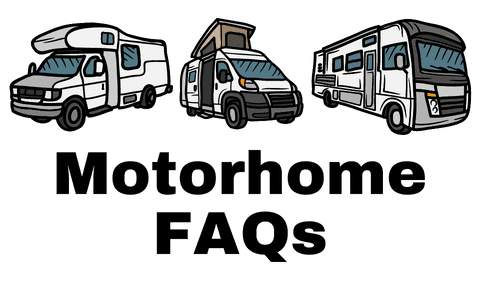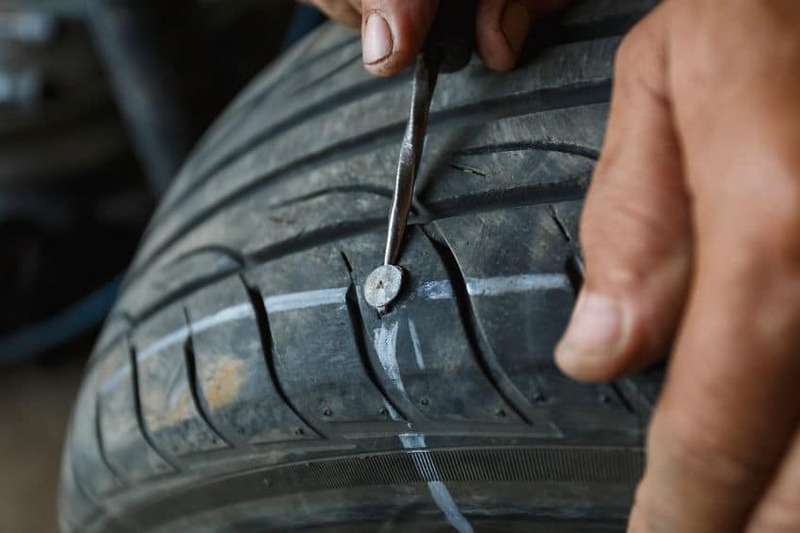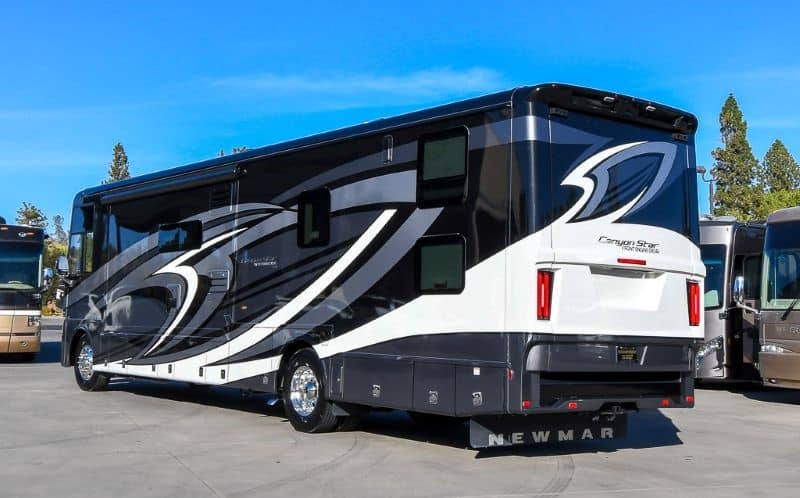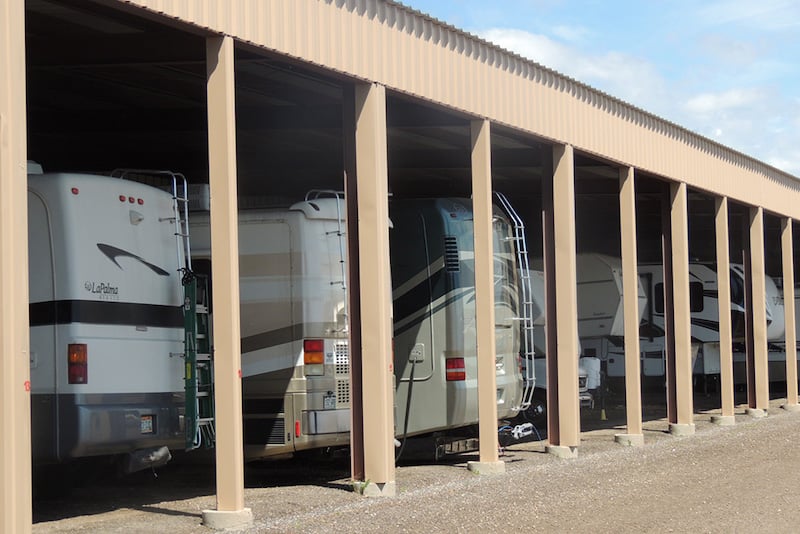The tires are a vital part of your motorhome. It doesn’t matter what kind of RV you have—motorhome or towable—without tires, you go nowhere. So if one of them blows, can you patch or plug RV tires to get back on the road?
When you purchase your RV, you plan to visit many destinations nearby. Even with good tires, objects on the road, various contaminants, and even sitting in storage for long periods can make them vulnerable to losing air.
While maintenance is the best way to avoid having to replace, patch, or plug your RV tires, they’re not invulnerable. So the question remains:
Can you patch or plug your RV tires? The simple answer is no. Read ahead to learn more about RV tires and why using a patch or plug isn’t recommended.
Can You Patch or Plug an RV Tire?
I know; I just said you can’t patch or plug your RV tires. But you can do this on a very temporary basis. If you have a tire issue on the road and you need to get to the nearest shop for a new tire, then by all means, do what you need to do.
What’s the Difference Between Plugging and Patching an RV Tire?
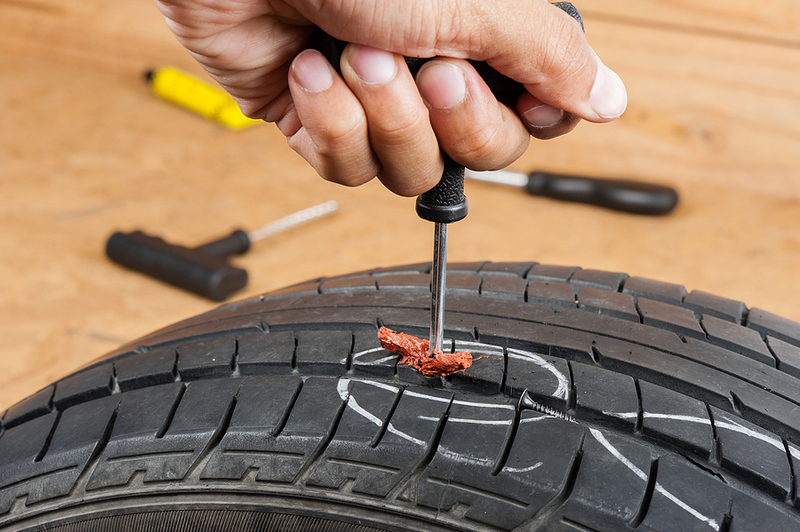
A tire plug is a sticky, expandable piece of rubber that gets pushed into a hole of a tire from the outside. This a quick and easy process to stop the leak and get to a place to replace the tire. It’s not recommended that you use this as a long-term fix for the tire.
Tire patches are glued on the hole inside the tire. The tire is removed to make this repair and is considered a more permanent solution. However, note that a tire can’t be patched if it’s been plugged.
The process of plugging a tire makes it unable to be patched.
Is It Better to Plug or Patch an RV Tire?
Patches are usually better than plugs for bigger holes or holes that are close to, but not on the sidewall. If your tires are dry rotting or the hole is on the sidewall, don’t patch it; get the tire replaced.
Tire plugs can cause air to become trapped between the layers of the tire tread, eventually causing the tire tread to separate. They can also wear down over time and allow air to leak. This is another reason not to use a plug for anything other than an emergency. Tire plugs also don’t seal off the inner liner from air or water entering the tire.
The U.S. Tire Manufacturer Association (USTMA) and the Tire Industry Association (TIA) don’t consider a tire plug repair a legitimate or safe repair method.
How Do You Patch an RV Tire?
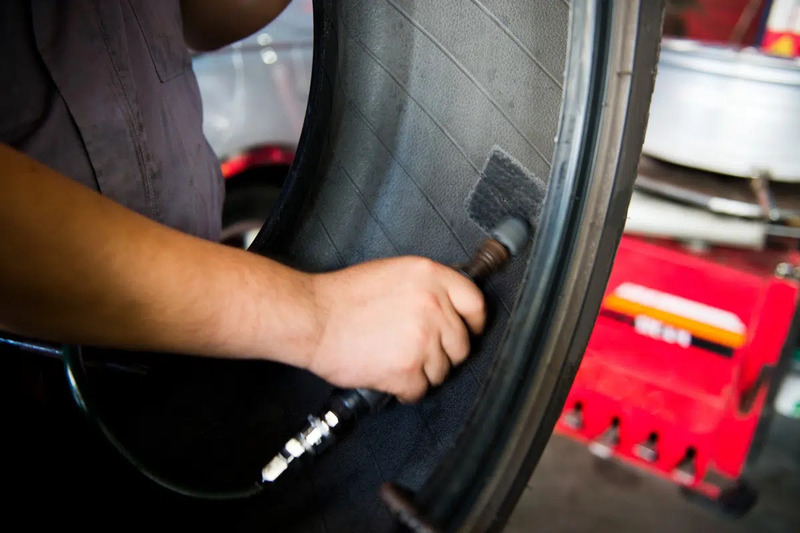
Patching an RV tire can be done by the owner if you have the correct tools and some knowledge. It’s recommended that you have a professional who can easily remove the tire, seal it, and replace it. They can also inspect the tire for other damage or dry rot.
The patch is placed on the tire’s inside and pushed outward by air pressure. Generally, they’re a better fix, but we still recommend replacing patched or plugged RV tires as soon as possible. Remember, they’re meant as temporary fixes, not permanent solutions.
How Do You Plug an RV Tire?
A tire plug is a sticky, expandable rubber material that’s pushed into the tire’s hole. The best way to plug a tire is to remove it from the rim, but it can be done on the rim in certain cases.
Plugging the RV tire while on the rim won’t allow you to see and inspect the inside of the tire for potential damage to the interior sidewall. Either way, a plug is a temporary fix that’ll get you to a tire repair shop that’ll replace the tire.
Can Fixing Your Own RV Tire Void Your Tire Warranty?
Yes, many tire manufacturers will void the manufacturer warranty on the tire if it’s improperly repaired. Patching or plugging RV tires on your own fits under this description if the patch isn’t completed correctly.
All tire plugs usually aren’t allowed due to the process. When plugging a tire, the hole in the tire must be drilled, or the tools further damage the tire by expanding the hole. Always check your warranty before plugging or patching your RV tire.
How Far Can You Drive With a Plugged Tire?
It’s not advisable to drive any distance with a plugged tire. If you have to plug the tire on the roadside, your best solution is to drive to the nearest tire shop. Having a good RV roadside assistance program that brings a new tire out to you, it’s a good idea to call and have the tech replace the tire.
If you must drive some distance, please drive slowly, avoid driving for extended periods of time or on busy roadways, and check your tire pressure often. A good tire pressure monitoring system, like the TireMinder System, will help with this last one.
How Long Does a Tire Plug Patch Last?
The problem with a tire plug patch is you won’t know how long it might last. It’s not a long-term fix for your RV tire, and you should consider your rig. Also, your passengers are vulnerable if you have a tire with a plug. Don’t use a tire plug any longer than necessary.
Can a Tire Plug Be a Permanent Fix?
No, you should not consider a tire plug to be a permanent fix. Your manufacturer and RV service professionals don’t consider RV tire plugs a true fix. Therefore, you’ll be putting yourself and your family in danger by thinking it’ll fix your tire. Don’t use a tire plug as a permanent fix.
Should You Plug or Replace an RV Tire?
Always consider a plug as a temporary fix for your RV. Get your tire inspected and replace the damaged tire as soon as possible. Tire blowouts are a hazard on the road. They can cause you to have damage to the underside of the RV that can keep your RV in the shop for weeks or months.
A tire blowout can also cause you to lose control of your RV, causing it to flip or roll over and put other drivers in danger.
Can You Drive an RV with a Flat Tire?
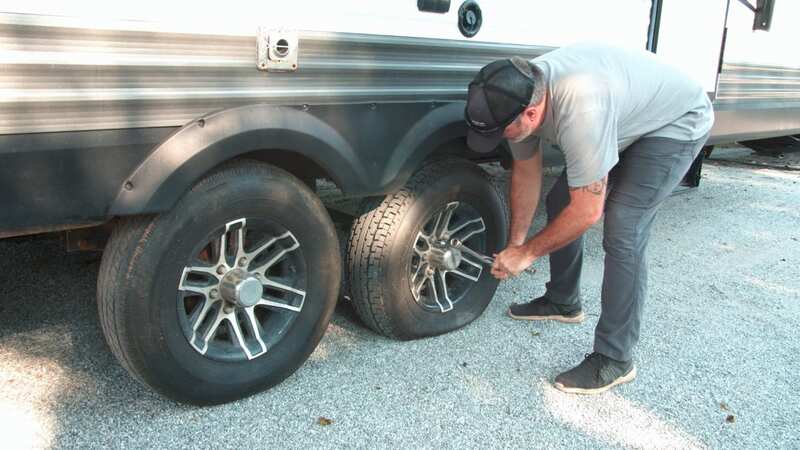
Don’t drive your RV with a flat tire. As soon as you know you have a flat, find a place where you can pull over safely. Obstacles such as road construction or a closed shoulder might make you drive for a short time. Put on your hazard lights and drive slowly.
Find somewhere that you can pull all the way off the road. Make sure the area is relatively flat. Always put out markers, cones, or flares to let other drivers know you’re broken down and servicing your vehicle.
Replace your tire with a spare if possible (or have an RV road tech do it), and then continue to the next RV tire repair. The nearby mechanic can inspect your tire and find a new tire shop in the area to continue your trip if your spare isn’t up to the task.
How Can I Find RV Tire Repair Near Me?
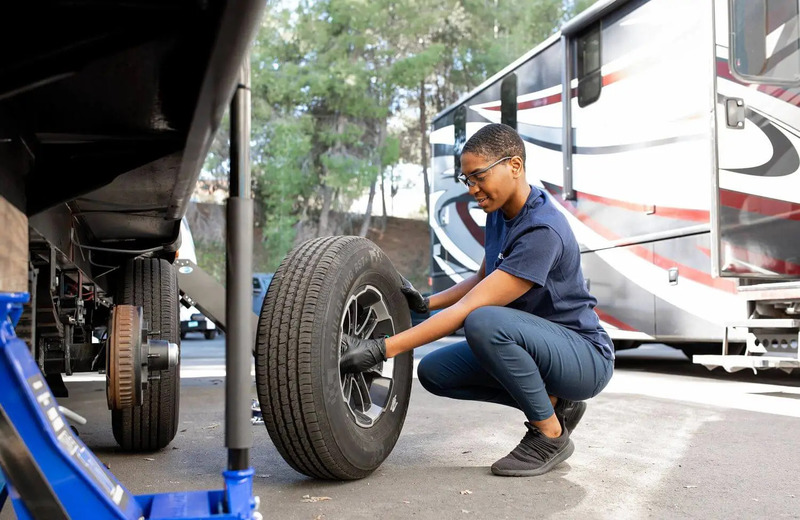
If you can make it to a nearby RV park, or your next destination, other RVers are a great resource. Ask locals if you can. Nearby RVers can recommend a good store or chain that might be in the area.
Google is a great source of information. Be sure and look at reviews and make some calls before you take your tire in for repairs. Of course, your RV roadside assistance representatives can help you too.
6 Best Ways to Avoid a Flat RV Tire?
There are several ways you can avoid a flat RV tire. Taking care of your tires is the best defense against tire problems. Here are a few ways you can avoid a flat tire and the expense and hassle of being stuck on the road.
1. Maintain Proper Air Pressure
Keeping proper air pressure in your motorhome’s tires is important in avoiding blowouts. A tire pressure monitoring system can save you money from having to patch or plug your RV tires. It helps you keep an eye on air pressure and temperature throughout your drive.
Always follow the manufacturer’s instructions on the inflation of your tires and consider the outside air temperatures when you fill them.
2. Watch Where You’re Driving
Driving your rig on dirt, gravel, or questionable roads can cause damage. Even road construction on the highway can cause a puncture with a nail or screw. It doesn’t hurt to quickly inspect your tires at every gas station or rest stop. Especially if you have been on bad roads.
3. Don’t Go Too Fast
Excessive speed while pulling a trailer or just driving your motorhome can cause tires to heat up, partly because of the weight these tires carry. Most RV tires are rated between 55 and 75 mph. I would suggest keeping to the middle of that recommendation.
4. Don’t Overload Your Rig
Overloading your rig can also cause tires to blow out. Know your RV’s Gross Vehicle Weight Recommendation (GVWR) and keep it underweight.
Cat Scales are a great way to keep an eye on your rig weight. They are located everywhere and are easy to use. The fee for Cat Scales is around $12. It’s a small amount to pay to keep you safe on the road.
See our article on How Much Can a Class A Motorhome Tow to learn more about motorhome weight and towing limits.
5. Avoid Storing in Direct Sunlight
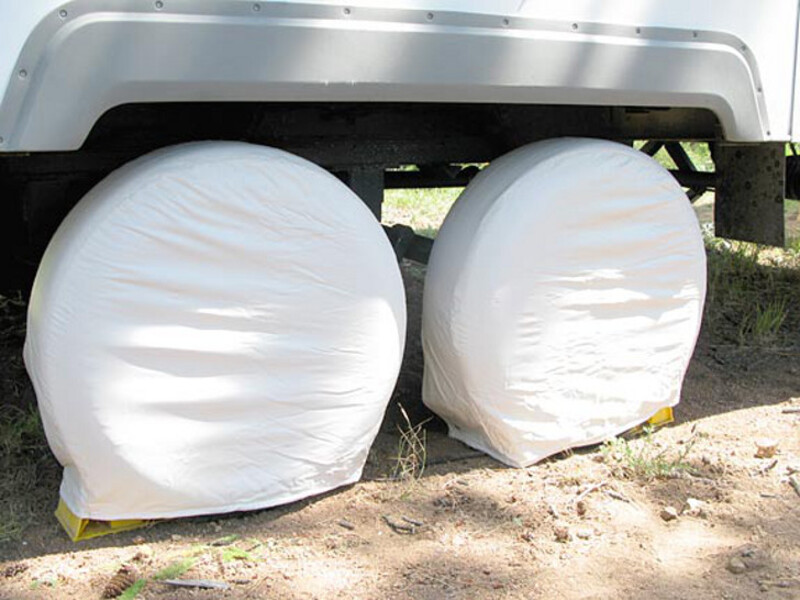
A covered or enclosed place to store your RV is great but not always feasible. Climate-controlled storage is a great but expensive option. If you can’t store your RV in one of these or live in it year-round, ensure you have RV tire covers that will block out the UV light. This can cause cracks in the sidewall that can lead to tire failure.
Make sure your cover is white or tan. Avoid buying grey or black tire covers. Buy a UV, mildew-resistant cover with elastic bands for easy installation.
6. Replace Tires at Mileage Recommendation
Proper maintenance of your tires will go a long way toward keeping them useful and safe for their lifetime. Make sure you replace your tires at the mileage recommended by the manufacturer. Some recommend replacing your tires in 5-8 years, even if they haven’t had much use. Replace them sooner if you see any evidence of dry rot.
Final Thoughts on Patching or Plugging RV Tires
Patching or plugging your RV tires is just a temporary fix. Never use a damaged RV tire longer than absolutely necessary. Bad tires put everyone on the trip at risk, and those who might be in their vehicles nearby.
My friend was recently escaping Florida from a hurricane and then had to rush to a family emergency a thousand miles away. He had a blowout and had to use a plugged used tire to finish the drive. It got him to his destination, but it later blew again on the way home.
He recommends getting through the emergency and buying a new tire—not a used one.
Also, don’t let your tires get to the point of dry rotting. Proper tire maintenance is also a good way to keep your RV tires in the best condition.
Never underestimate the problems that a blown tire can cause. It’s always better to be safe than sorry when it comes to your family.
Related Reading:
9 Best Air Compressors for RV Tires
Should You Fill Your Travel Trailer Tires With Nitrogen?
Definitive Guide to an Extended RV Warranty for Motorhomes
About the Author:
Terri Nighswonger and her husband Todd have been RVing and work camping for five years with their Cavalier King Charles Spaniel, Newton, and their Minnie Australian Shepherd, Remi.
They originate from the Midwest but plan to enjoy the West for a few years, wintering in Arizona and summering wherever the road may lead. Writing is Terri’s passion, but she also loves hiking, kayaking, walking her dogs, and anything she can do outdoors.

